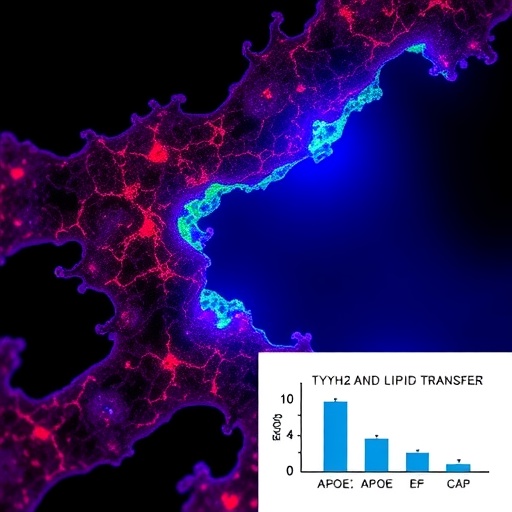In a groundbreaking advance in the understanding of lipid transport and cellular membrane dynamics, new research has unveiled intricate interactions between the protein TTYH2 and APOE-containing lipoprotein particles. This revelation sheds light on a hitherto elusive mechanism facilitating the transfer of lipids within endosomes, a process critical for maintaining cellular lipid homeostasis and membrane integrity. Drawing from state-of-the-art cryo-electron microscopy (cryo-EM) and biochemical reconstitution techniques, the study offers a detailed structural perspective of how TTYH2 engages with disc-shaped APOE lipoproteins, further illuminating the molecular choreography underlying lipid transfer at the cellular interface.
The researchers initiated their investigation by focusing on the recently identified interaction region between TTYH2 and unlipidated APOE. This foundational insight raised an important question: does TTYH2 interact similarly with APOE when it is incorporated into lipid-bound lipoprotein particles? To address this, the team successfully reconstituted disc-shaped lipoprotein particles, mimicking natural APOE-laden assemblies containing cholesterol and phospholipids, which were then introduced to either detergent-solubilized purified TTYH2 protein or cell-derived vesicles expressing TTYH2 in abundance. This dual approach enabled the exploration of TTYH2’s behavior in both isolated and membrane-embedded states.
High-resolution cryo-EM data revealed a heterogeneous distribution of particles when combined with detergent-solubilized TTYH2. Among these, discrete populations were identified corresponding to lipoproteins, TTYH2, and crucially, their complexes. The team reconstructed three distinct oval-shaped disc-like assemblies ranging in diameter from approximately 130 to 150 Å, dimensions consistent with APOE containing nanoparticles that incorporate lipids such as cholesterol and phospholipids. These structures exhibited a characteristic bimodal bilayer density corresponding precisely to the lipid head-group regions, confirming the fidelity of the reconstituted particles in replicating authentic lipoprotein discs.
Further refinement and classification of three-dimensional (3D) reconstructions provided compelling evidence of TTYH2-lipoprotein complexes. The cryo-EM maps, resolved to between 13 and 14 Å, revealed a clear density attributable to bound lipoprotein discs, mirroring the size and shape of free-standing lipoprotein particles. Notably, the binding interface was localized to the extracellular domain of TTYH2, overlapping with the previously characterized binding region for unlipidated APOE. Although current resolution limitations precluded atomic-level detail, this spatial proximity highlights a conserved binding motif that likely governs the affinity between TTYH2 and APOE irrespective of APOE’s lipidation status.
One of the most fascinating observations was the orientation of the lipoprotein discs relative to TTYH2. The portion engaged with the extracellular domain was found adjacent to the protein’s hydrophobic cavity — a structural feature known to harbor lipid-like density. This cavity had been unequivocally characterized in prior high-resolution structures of TTYH proteins, including the present study’s novel TTYH2 conformation. The spatial arrangement suggests a mechanism whereby TTYH2 directly interfaces with the lipid-rich face of the lipoprotein disc, positioning lipids in close apposition to the hydrophobic cavity and potentially facilitating lateral lipid transfer into the cellular membrane or endosomal vesicles.
Complementing the observations made with detergent-solubilized protein, a parallel structural analysis was performed on TTYH2 expressed within cell-derived vesicles. These in situ studies, yielding a reconstruction at 10.7 Å resolution, confirmed the preserved nature of the TTYH2-lipoprotein interaction within a native membrane environment. The extracellular domain of TTYH2 retained its lipoprotein-binding capacity, reinforcing the biological relevance of these interactions in physiological contexts. Importantly, the cytoplasmic domain, distinctly visible in these reconstructions, underscores the integral membrane protein architecture and suggests possible intracellular signaling or structural roles concomitant with lipid exchange.
The significance of these findings extends beyond structural novelty. TTYH2 appears to act as a molecular bridge, coupling extracellular APOE-containing lipoproteins with the cellular membrane to effectuate endosomal lipid transfer. This role resonates with longstanding hypotheses positing TTYH family proteins as facilitators of lipid trafficking and homeostasis. By providing a direct physical pathway for lipid molecules from lipoprotein particles into endosomal membranes, TTYH2 may modulate lipid composition in membranes, influence membrane fluidity, and impact cellular signaling cascades reliant on lipid mediators.
This novel structural insight also casts light on the physiological and pathological relevance of APOE isoforms. Given APOE’s central role in neurobiology, cardiovascular disease, and lipid metabolism, understanding how its lipoprotein forms interact with membrane proteins like TTYH2 could unlock new therapeutic avenues. For conditions such as Alzheimer’s disease, where APOE variants differ in lipid handling and neuronal impact, modulation of TTYH2-related lipid transfer pathways may offer a strategy to attenuate disease progression or restore lipid balance.
The study’s methodological rigor is notable, combining recombinant protein expression, biochemical reconstitution of lipoprotein discs, advanced cryo-EM imaging, and sophisticated 3D classification protocols. This integrative approach ensures that interpretations of the protein-lipoprotein complexes are grounded in structural authenticity and biological plausibility. The careful delineation of particle heterogeneity, coupled with targeted classification to isolate complexes, exemplifies the power of cryo-EM in resolving dynamic macromolecular assemblies.
Looking forward, the challenge remains to achieve higher resolution structures that can reveal atomic details of the TTYH2-APOE interface. Such advances would clarify specific amino acid interactions, the nature of lipid coordination within the hydrophobic cavity, and the dynamics of lipid transfer. Additionally, functional assays measuring lipid flux mediated by TTYH2 in living cells could complement structural data and validate the proposed lipid-transfer mechanism.
In conclusion, this pioneering work uncovers a sophisticated molecular interaction network wherein TTYH2 collaborates with APOE-containing lipoproteins to facilitate lipid transfer at the cellular interface. The detailed structural characterization of this complex opens new vistas into membrane biology and lipid metabolism, with far-reaching implications for understanding fundamental cellular processes and disease mechanisms involving lipid dysregulation.
Subject of Research: Interactions between TTYH2 and APOE facilitating endosomal lipid transfer.
Article Title: Interactions between TTYH2 and APOE facilitate endosomal lipid transfer.
Article References:
Sukalskaia, A., Karner, A., Pugnetti, A. et al. Interactions between TTYH2 and APOE facilitate endosomal lipid transfer. Nature (2025). https://doi.org/10.1038/s41586-025-09200-x
Image Credits: AI Generated




